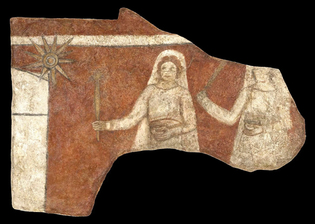
Yale University Art Gallery
A wall painting in the baptistry of the “Christian building” at Dura-Europos, in the collection of the Yale Art Gallery.
View full image
For centuries, one of early Christianity’s most potent symbols has been the “house church”—a concept originating from the idea that the religion’s earliest worshippers met in private homes, possibly secretly. Yet aside from references in the Bible, evidence of such domus ecclesiae from before the period of Emperor Constantine (306–337 CE), who legalized Christianity, has been elusive.
Recently, scholars have determined that the only pre-Constantine “house church” which archaeologists thought they had securely identified—a third-century dwelling in Dura-Europos, an ancient Roman settlement in modern-day Syria—was unlikely to have been a home at the time it was used for worship.
“Are we just projecting modern assumptions back onto the archaeological record? In this case, we absolutely are,” says Yale University archaeologist Camille Leon Angelo ’25PhD, a doctoral student in religious studies.
Angelo first started to interrogate the story of the Dura-Europos “Christian building” in 2017, when she came across research about when the term domus ecclesiae was popularized. “The term was actually not in use prior to Constantine,” she says. “I thought, ‘Well, the term’s not in use, and we have only one building. Is it really what we think it is?’ ”
Building on work by archaeologist Jennifer Baird, and along with University of Manchester architectural researcher Joshua Silver, Angelo put together a dataset of 62 buildings in Dura-Europos that had been determined to be residences. Just 9.5 percent of these homes had both a courtyard staircase and wall paintings or pictorial graffiti, as the Christian building did. And only the Christian building had a staircase and paintings, and lacked a cistern. It didn’t have other shared elements of residential homes, such as an area to cook food.
“No other house had the same combination of features as the Christian building,” Angelo notes.
Angelo and Silver also used 3D simulations, light modeling, and even analyses of patterns of movement—based on the locations of features like windows and doors—to understand how people would have used the space. Alongside elements like a baptismal font and a Good Shepherd painting, these clues clearly indicated it was used for Christian worship.
The more they looked, the clearer it became that the Christian building was just that, and not a domestic home. Meanwhile, indications on the structure’s exterior meant that worship there didn’t seem to be hidden. “My suspicion, strongly,” Angelo says, “would be that other people at Dura, beyond the Christians, knew that Dura Christians gathered there.”
The belief that “house churches” existed because they allowed persecuted Christians to worship in private is deeply rooted. But this study is the latest piece of scholarship to hint that, at least when it comes to the archaeological record, hard evidence for the belief is thin.
 loading
loading